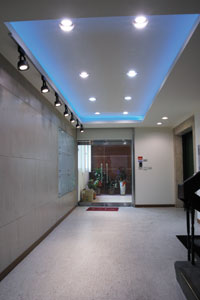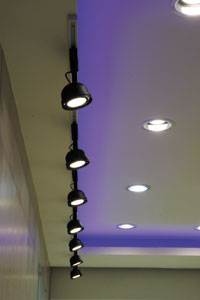ColorStar Group to Launch IPO Stateside to Finance Globalization Plan
2008/10/09 | By Ken Liu | COLOR STARS, INC.Clearly focused on expansion, LED-lighting maker ColorStar Group, headquartered in Bay City, Michigan, will launch initial public offering (IPO) this year in the U.S. "With infusion of more capital, which is critical to any serious development program, we would be poised to acquire more necessary facilities and technologies to enhance LED manufacturing capabilities," stresses Jimmy Chen, president and CEO.
The company specializes in high-power LED thematic-lighting systems. Chen's plan basically includes vertical integration to develop more flexible designs and sustain competitiveness: by bringing onboard upstream LED-lamp manufacturing and downstream LED-emitter manufacturing. "Actually, we've just taken a first step in our M&A plan-having just acquired an emitter maker through stock swap," Chen notes.


Preferring the design-flexibility concept, Chen believes the ideal way to build his outfit is to combine lighting-fixture manufacturing and LED packaging, bypassing the thermal-module stage. "Such combination will allow chips to be directly packaged onto lighting fixtures, removing the limits that have long confined design flexibility. I believe this arrangement will be realized soon as packaging technologies have improved considerably, with thermal issues becoming less thorny at this stage," he explains.
Chen also feels packaging-service providers is the most likely candidate to realize the combination for having better knowledge of process integration relative to lighting-fixture manufacturers. "Module manufacturing will vanish once the two sectors combine," Chen predicts.
Manufacturing Plans
ColorStar has plans for four product categories-emitter and controller, lighting system and controller, driver-editing software, lighting fixture-and looks to setting up four branches to individually take on the fabrication. "LED lighting being a huge sector composed of several specialized segments, so I believe the feasible strategy is to recruit more professionals, via M&A, from the four fields," Chen says.
ColorStar has its work virtually cut out. Taiwan's well developed lighting, semiconductor, and electronics sectors, Chen says, provide the world's most suitable backdrop for LED lighting integration, boasting as proof that "For instance, we've built a wirelessly controlled, dimmable thematic lighting system by tapping the island's wireless and dimming technologies." The ZigBee system can wirelessly control a maximum of 170 lamps at a time.
Should the group succeed with its IPO stateside, it will gradually shift operational focus from the fully-owned subsidiary ColorStar Inc. in Taiwan to the group's American headquarters. "No LED lighting manufacturer outside the U.S. has launched such an IPO," Chen boasts.
Emulating Garmin
Following in the footsteps of Garmin Ltd., the world's leading GPS maker co-founded by a Taiwanese and an American in the States and operating its largest subsidiary in Taiwan, the ColorStar CEO aims to mold his business more corporate American. "Having first promoted our brand name stateside six years ago, we have become the world's first LED-module maker and LED-lighting project builder to have succeeded in branding. Now, we are a well known brand in the American LED-lighting segment with 200 distributors worldwide," he reports.
Chen says delivering quality underlies the company's successful brand marketing, which in turn advertises the company's products by word-of-mouth. "Our LED bulbs emit the industry's most consistent brightness," he stresses to prove the company's quality. "Such excellent performance is realized by our constant-current drive IC in the control system," Chen says, adding that his company spent NT$2 million (US$64,500 at US$1:NT$31) developing the control chip.
Without taking all the credit himself, Chen lauds his management team for achieving such high quality, with the team members, including himself, being electronics, telecom and lighting specialists who have worked for Acer, Philips and Westinghouse. Stressing his company completely focused on technology R&D in 2002, the year of establishment, and began production in the second year, Chen notes that the company chose the hardest applications for LED lamps, with thematic-lighting systems falling in such group.
In addition, the company's product R&D team consists of engineers formally-trained in materials, optics, electronics, software and semiconductor sciences.
Adopting software, hardware technologies, including constant-current drive IC, the company's thematic-lighting systems are superior to rivals'. "We are the most vertically-integrated LED lighting maker in the sector with downstream applications with upstream LED packaging capabilities," he says.
American Image
Chen's globalization idea was sparked while working as an engineer for Westinghouse many years ago: "The American giant, a household name in home appliances and illumination products, shed light on the power of globalization," he recalls. Chen's ambitious plan to go global shrewdly includes Sam Ritchie, ColorStar's project manager who was formerly a U.S. government employee. "Employing an American native smoothes doing business by setting up the solid American image for world buyers," Chen explains.
Product Evolution
Initially the company developed wired thematic-lighting systems, but now wireless systems dominate its product line. Strategically, the company has diversified from big architectural lighting systems to making smaller systems for household decorations. "This is a two-pronged strategy...although big systems are relatively more lucrative, but smaller systems have a bigger market base," Chen notes. However, big systems still generate 80% of corporate revenues, and include 36W products rated at 1,200 lumens and 108W ones emitting 3,000 lumens, all of which adopt LED chips from Cree and Lumileds.


Product Availability
Besides being available in the States, the company's products are also sold in Europe, mainland China and Taiwan; while ColorStar has a solid track-record: the company's lighting systems have been installed at the Hitech Department Stores in Tienjin, China; Guandu Bridge in Taipei, Taiwan; Sands Casino, Macao; SPA at Oaks Golf Club in Britain; Oracle Shopping Center in Britain; the Hondo Hotel in Taiwan; the Alter Ego Bar in Britain; Tainan Cultural Center in Taiwan; and Chung Yuan Christian University in Taiwan.
Enviable Leader
Chen says his company's products are always market leaders that end up being copied. But introducing innovative products yearly somewhat protects the company from imitators, as only older products are duplicated. He stresses that LED-lighting quality hinges on three elements-lens, thermal module, and drive current. "Many copycats simply do not have know-how related to these three critical components. Plus the industry stresses market timing, so only those who offer the right products timely can succeed," Chen stresses.
Building a specialized lighting company is Chen's ultimate goal: "We are setting up a database of our illumination values for lighting-designers to program into their software to properly meet illumination parameters," he says.




